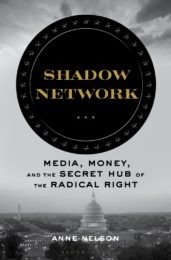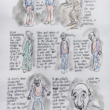One day in August 2004, as I drove down the street in my hometown of Stillwater, Okla., I tuned the radio dial to a new station. I settled on a random call-in show and sat back to listen. The host was denouncing the candidacy of John Kerry in terms that went something like this. “He legalized gay marriage in Massachusetts,” he said. “That’s exactly what he’ll do all over the country if he gets elected president of the United States.”
An anxious elderly woman called in. “I’ve been married to my husband more than 40 years—are you saying my marriage would be in danger?” “That’s right,” he answered. “John Kerry is threatening the sanctity of marriage, including yours. So you better get out and vote.”
When I arrived at my destination, I parked in the driveway to listen to the rest, just to make sure I’d gotten it right. I’d heard debates about same-sex marriage in New York, but none of them suggested that it would challenge the legitimacy of heterosexual marriage. But I dismissed the broadcast as a regional curiosity. After all, I was in a middling town in a deep-red state, and I thought the influence of a radio preacher was unlikely to reach beyond a local audience.
The following years brought historic milestones, including the inauguration of our first African-American president, environmental protections, and the legalization of same-sex marriage. But the same period witnessed a social and political backlash that took aim at the very institutions of American government, leading to the rise of the Tea Party, obstructionist Republican majorities in Congress, and the stunning election of Donald Trump in 2016.
America’s national news media were caught off guard, and experts scrambled to find an explanation. The New York Times turned to Fox News. Trump voters “don’t believe what anyone in the news media is telling them, except for maybe Fox News,” stated one op-ed. The New Yorker named The Apprentice as “the show that made [Trump’s] presidency possible.” A report from Harvard’s Berkman Klein Center pointed to news platforms, making a case that conservatives shunned professional online media organizations in favor of “pro-Trump, highly partisan media outlets,” such as Breitbart News.
Each of those factors played an important role. But as someone who has shuttled between the East Coast and the Midwest over the past four decades, I saw mounting evidence of a larger force at work: the rapidly evolving ties connecting the man power and media of the Christian right with the finances of Western plutocrats and the strategy of right-wing Republican political operatives. Many of their connections were made through a secretive organization called the Council for National Policy, which, as one member has said, brings together the “donors and the doers.” I call it the Shadow Network.
The CNP was founded in 1981 by a small group of archconservatives who realized that the tides of history had turned against them. They represented an American past dominated by white Protestant male property owners. They dreamed of restoring a 19th-century patriarchy that limited the civil rights of women, minorities, immigrants, and workers, with no income tax to vex the rich or social safety net to aid the poor. Now they faced a future in which minorities, women, gays, and atheists were gaining in number, rights, and political influence. If the country abided by a clear-cut democratic process, these constituencies, leaning Democratic, would consolidate their power based on majority rule. So the CNP decided to change the rules. This task would require developing a long-range strategy to target critical districts and activate previously unengaged voting blocs. But, as author David Daley has pointed out, the conservatives faced a deadline: once Democratic-leaning youth and minorities reached a decisive majority—which could be as early as 2031—there might be no turning back.
The CNP spent decades building a framework to advance its agenda. One pillar has been its ability to master the basic rules of media and write new ones. The massive disruption of the news media has contributed to the fractured state of our politics. Middle America has been a victim of a colony collapse in journalism, triggered in part by the headlong rush for profits in the news industry in the late 20th-century. As local and regional newspapers went out of business during the early 2000s, media owned by CNP members rushed to fill the vacuum. They developed a sophisticated strategy, starting with local radio, an old-fashioned but powerful medium that had been written off too soon by the CNP’s opposition.
Hundreds of broadcast outlets, such as the radio station I heard back in 2004, belong to members of the CNP. Three key players dominate this landscape: Salem Media Group, Bott Radio Network, and the American Family Radio networks. Over the years they have connected their holdings to a cohort of pastors, politicians, and tycoons, creating an armada of radio stations and news outlets loyal to the CNP’s political agenda and selling millions of Americans on its harsh combination of plutocracy and theocracy.
Their programming is not uniform, but it harmonizes. In Detroit, Salem Media’s WDTK (“The Patriot”) stokes the ire of disaffected Rust Belt listeners with complaints about the economy and immigration. The same network offers its audience in Little Rock, Ark., its “first FM commercial Christian Talk and Teach station. . . . Our partnership with national programmers and local churches, ministries and businesses ensures that our listeners will receive solid teaching and informative talk.” American Family Radio preaches the dangers of modern science and “moral decay”: “The complete absence of transitional fossils disprove evolution,” it tells listeners, and it reports that, “God agrees. . . that homosexuality should be against the law.”
Because these stations’ audiences have lost or abandoned professional news outlets—and because their interests had been ignored by major national media—they are more vulnerable than ever. Over time, the media empire has expanded its reach into Fox News operations and grown to include fundamentalist television broadcasting, digital platforms, book publishing, and feature-film production.
The “wallpaper effect” of wraparound media can have a powerful impact. Abraham Hamilton III, host of American Family Radio’s Hamilton Corner, described the Oct. 1, 2017, mass shooting in Las Vegas as “Satan’s work,” immune to legislation. The Democrats, he complained, were “exploiting” the victims by calling for hearings on gun control. This charge was repeated, often in the same language, by other CNP-affiliated political and media figures across platforms, including the Daily Signal, the Hillsdale Collegian, and Fox News’ Todd Starnes Show. The cumulative effect is the creation of a parallel universe of information. The results have been devastating to American democracy, as two parts of our country constantly talk past each other.
CNP strategists showed an astute grasp of electoral politics, finding hidden pockets of evangelical voters and identifying the issues that could drive them to the polls. They displayed a special talent for pinpointing the districts and swing states that could win them critical victories. The intricate mechanics of the Electoral College and redistricting presented a narrow window to circumvent the popular vote, and they seized the opportunity.
The CNP and its allies spent years building party machines at the state level. The Republican control of statehouses supported their gerrymandering efforts, and powerful donors helped them tackle labor unions in Wisconsin, Michigan, and other former Democratic strongholds. When unions lost the right to collective bargaining in the Rust Belt, it crippled their ability to represent their members in the political process. The statehouse stratagem also allowed the CNP and its allies to use state governments as staging grounds for aspirants to national office. One such state was Michigan, the home of Trump’s secretary of education, Betsy DeVos, and her powerful clan; another was Vice President Mike Pence’s Indiana.
The CNP originated in the “Conservative Resurgence” of the Southern Baptist Convention in the 1970s and early ’80s, which reversed a trend toward liberalization and purged moderates from church institutions. The movement learned from this success and replicated it, developing an impressive capacity to co-opt existing organizations and draw them into its web. One example is the National Rifle Association, a former gentlemen’s marksmanship club that has been weaponized for political purpose.
The CNP set its sights on the Republican Party, conducting a decades-long crusade to promote right-wing extremists and drive moderates out of office. One of the most surprising elements of this story is the coalition’s fusion of digital campaign tools to its grassroots organizations and media.
Stung by Obama’s successful digital strategy in 2008, the movement turned to the Koch brothers’ state-of-the-art i360 data platform, linking data and ground troops to a new generation of networked apps. This marriage was designed to reach targeted populations, creating discreet communications channels that were hardly visible to opponents and national news media. As Democratic strategists note, their party has sophisticated digital tools but a less cohesive organizational structure.
Meanwhile, groups run by CNP members and their favored candidates benefit from a subsidized, turnkey digital package. Their coordinated apps collaborate across platforms and weave seemingly independent groups into tightly networked operations.
These measures played a significant role in the 2016 surprise and continue to affect the electoral landscape today. The CNP’s preferred Republican candidate that year was Senator Ted Cruz, but when Donald Trump won the nomination, the movement turned on a dime, delivering its national network of media and man power to carry his message, in return for his promise to advance its policy objectives. The impact of this network was borne out again in key races in the 2018 midterm elections, and can be anticipated for 2020.
Digital tools are unlikely to be effective if they are not rooted in social relationships. The movement has benefited from the gradual decline of mainline Protestant denominations and the rapid growth of the evangelical population over the past half-century. Pastors have been wooed, pressured, and sometimes bullied to adopt increasingly political stands.
The movement has also appropriated a vocabulary that it redeploys with Orwellian flair. “Family” is a code word for homophobic, and “defense of marriage” means prohibition of same-sex unions. “Fairness” and “justice” mean lowering taxes for the wealthy and corporations. “Values” means conservative evangelical ideology. “Right to work” means depriving unions of the benefits of collective bargaining.
The movement’s brand of “religious freedom” often disparages other beliefs, and would allow fundamentalist churches to support political campaigns while retaining their tax-exempt status. And in the lexicon of Betsy DeVos, crown princess of the movement, “educational reform” means redirecting public school funding to religious schools, charter schools, and homeschooling. All of these euphemisms promote policies that victimize low-income and minority populations.
 As I pursued my research for a book on the CNP (called The Shadow Network, it will be published this October by Bloomsbury), I’ve also acquired a stronger grasp of regional resentments. One marker is my struggle to label the vast region of the United States that lies between the coasts and increasingly functions as a political unit. It is often dismissed as “flyover country”—as though that’s a clever summation of a large and complex population that is often overlooked. (Another dismissive term is “the noncoastal area.”) I’ve seen glaring examples of the way national news media and the Democratic Party have taken these populations for granted, at a cost for all concerned. As these regions lose representation in the media sphere, they are all the more determined to claim it elsewhere.
As I pursued my research for a book on the CNP (called The Shadow Network, it will be published this October by Bloomsbury), I’ve also acquired a stronger grasp of regional resentments. One marker is my struggle to label the vast region of the United States that lies between the coasts and increasingly functions as a political unit. It is often dismissed as “flyover country”—as though that’s a clever summation of a large and complex population that is often overlooked. (Another dismissive term is “the noncoastal area.”) I’ve seen glaring examples of the way national news media and the Democratic Party have taken these populations for granted, at a cost for all concerned. As these regions lose representation in the media sphere, they are all the more determined to claim it elsewhere.
The CNP understood this. Its roots lie in the oil-producing states of Texas, Louisiana, and Oklahoma. One outcome has been the sudden prominence of individuals from those states under the Trump administration, in federal agencies, advisory bodies, and the Cabinet. Oklahoma, in particular, has served as an incubator state for the CNP’s political and social vision; my home state appears again and again as a breeding ground for the movement’s policies and advocates. My friends and family have watched with sorrow as environmental regulations have been suspended, public education has been gutted, and public health indicators have plummeted.
Under the Trump administration, the same model is being promoted at a federal level.
At the heart of the debate is climate. In a world where the options for preserving our environment are rapidly diminishing, advocates of sustainable growth face a movement set on accelerating the damage in the interests of short-term profit.
Health, education, and welfare are also under attack. The rights of women, gays, minorities, and immigrants are at stake. On the economic front, a shell game is taking place. It’s no secret that the electorate can be seduced by deceptive economic upticks, based on slashed entitlements and historic levels of debt. Members of the CNP have worked in concert with affiliates of the Koch network to advance these goals, at a mounting cost to the polity.
The CNP has labored in the shadows, but not in utter darkness. Some leading members made headlines in past decades, including Tim LaHaye, Jerry Falwell, Paul Weyrich, and Richard Viguerie. Others may be less familiar to the reader, including Stuart Epperson and Edward Atsinger III of Salem Communications, Richard P. Bott Sr. and Jr. of the Bott Radio Network, and the Wildmon family of the American Family Association.
Vice President Mike Pence emerges not as a meek sidekick, but as an indispensable bridge to power.
Here you will find the myriad ways that money, media, and mobilization have been synchronized in the pursuit of power and profit. The story is peopled by shrewd, remarkable and sometimes unscrupulous characters and is rife with unexpected connections and synchronicities. The larger picture is one that the American public needs to understand. We must ask ourselves whether the country the CNP has planned for us is one we can accept for ourselves and our children.
This essay was adapted from the prologue of Shadow Network: Media, Money, and the Secret Hub of the Radical Right, Anne Nelson’s chilling new book about the covert group that masterminds the Radical Right’s ongoing assault on American democracy. Out at the end of October, Shadow Network can be pre-ordered here. Nelson is the author of Suzanne’s Children; Red Orchestra: The Story of the Berlin Underground and the Circle of Friends Who Resisted Hitler; Murder Under Two Flags: The U.S., Puerto Rico, and the Cerro Maravilla Cover-Up; and The Guys: A Play. Her work has appeared in The New York Times, Los Angeles Times, Harper’s, the BBC, CBC, NPR, and PBS. She teaches at the Columbia School of International and Public Affairs in New York City.







Thanks for the giggles. Keep misunderstanding what motivates average Americans; it will continue to be to your detriment.
Carlos, what motivates average Americans then? I would love to see what you have to say.
Average Americans are self-centered to an extreme beyond comprehension.
(Drops the Mic)